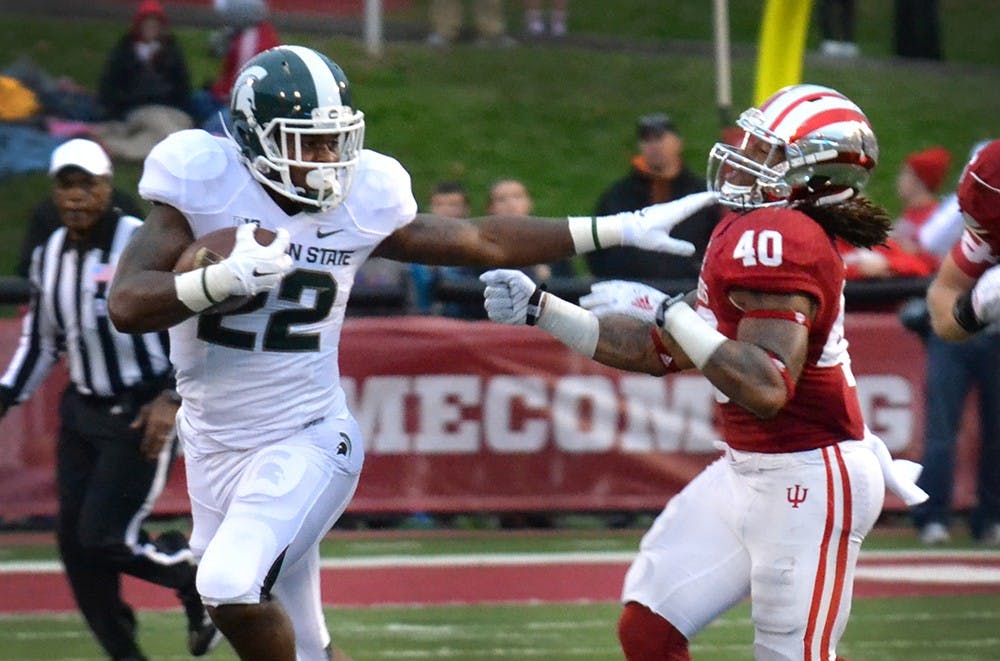But just barely.
The Hoosiers are no longer in the basement cellar of the Big Ten in scoring defense. That recognition goes to Illinois.
But IU’s defense, despite various improvements, has mostly remained the same.
IU is allowing 34.8 points and 445.4 total yards per game, both second worst in the Big Ten.
The Hoosiers have made noticeable strides in rush defense and in defensive third-down efficiency, but the points given up have remained mostly the same.
It’s improvement, nevertheless. And improvement is exactly what Knorr and IU Coach Kevin Wilson wanted this year.
“Coach Wilson always talks about continuous improvement,” Knorr said. “That’s what we’re trying to see not only as a defense, but each position group, segments, player by player.”
To Knorr, it breaks down to a simple question: “As a defense, are we getting ?better?”
Struggles in the red zone
When opponents get into the red zone against IU, they leave with points.
In 31 defensive stands in the red zone, IU has allowed 31 scores amounting to 156 points through eight games.
IU has allowed 21 total touchdowns (11 passing, 10 rushing) and 10 field goals.
The Hoosiers are the only team of 125 FBS programs without a defensive stop in the red zone this season. Call it Hoosier hospitality.
For comparison, the best red zone defense in the country, Mississippi State, has only allowed opponents to score on 57.1 percent of red zone trips.
Last season, IU was ranked 96th in the country allowing opponents to score 86 percent of the time.
“Our red zone defense, we got to get some stops,” Wilson said. “Red zone defense has to be more ?consistent.”
Senior safety Mark Murphy said the red zone gets treated a little differently on a given drive.
The defense tightens and emphasizes staying in front of the goal line, but to him, it’s mostly been a matter of needing a better attitude in the red zone.
IU better on third down
In a 2013 season characterized by struggles on defense, third-down defense stood out as a major reason for IU’s inability to keep opponents off the field.
Last year, the Hoosiers allowed opponents to convert on 46.2 percent of third-down opportunities, which ranked 114th in the nation.
When the defense can’t get off the field, the offense has no opportunity to score points.
It’s been a reoccurring problem in recent years for IU. Inabilities on third down have taken the bulk of the blame for IU having one of the Big Ten’s worst defenses.
That has largely changed this season.
IU ranks 51st in the nation this year with an opponent’s third-down conversion rate of just 37.7 percent.
“It’s definitely gotten better,” sophomore safety Antonio Allen said.
Rush defense improving
IU’s run defense was fully exposed by Navy in 2013 when the Midshipmen ran nearly at will against IU, accumulating 444 yards on the ground.
The inability to stop the run became a trend last ?season.
The Hoosiers gave up 237.9 yards per game, second worst in the Big Ten.
IU has cut that number by 67.3 yards per game this season, jumping to 10th in the Big Ten.
Murphy credited IU’s improvement to an emphasis on being able to stop the run this season.
“It’s always a work in progress,” Murphy said. “But it definitely has gotten better and that’s something we’ve been focusing on this year is you have to stop the run so you can stop everything else.”
Turnovers still an issue
All season, the defense has stressed turnovers, but the interceptions and fumble recoveries haven’t been coming as often as IU would like.
The Hoosiers had three plays against Michigan where a player was in position to make an interception. Only one was made by freshman safety Chase Dutra, but the following drive didn’t amount to points.
“We didn’t get it done as far as capitalizing on possible interceptions,” Knorr said.
Part of the problem, Knorr said, was a lack of pressure on the opposing quarterback.
There were times throughout Saturday’s loss that Michigan quarterback Devin Gardner was able to get the ball out of his hands within two seconds.
Other times, he had more than enough time to wait in the pocket for receivers to get open.
IU only has seven turnovers thus far this season after creating 17 last year.
Dutra said it is frustrating to not always get the turnovers when IU is in position to make plays but said the fact that IU is in position to make those plays is ?promising.
IU spent Sunday’s practice simulating chances to make interceptions in order to possibly create points off defensive plays.
“We still have to have more consistency,” Knorr said. “We need to see not only the young guys, and you’re going to see the most improvement by them, but the older guys, too.”




